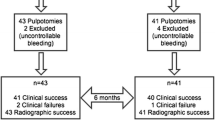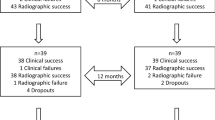Abstract
This study has aimed to evaluate the clinical and radiographic success rates of calcium hydroxide pulpotomy (CH) with biostimulation (PBMT) and compare them to that of CH, formocresol (FC), mineral trioxide aggregate (MTA) pulpotomies without PBMT in primary molars. A total of 172 pulpotomies were performed on primary first or second mandibular molars in 94 children who were 5–8 years old. The pulpotomy procedure was performed with four different techniques. In the PBMT group, before the CH placement, 820-nm diode laser radiation was applied to each pulp-stump for 12 s (10 mW, 2.5 J/cm2). The clinical (lack of spontaneous pain, abscess or fistula, and pathological mobility) and radiographic success (lack of periapical/furcal lesions and internal/external resorption) were recorded at 6 and 12 months. The data was statistically evaluated. p value < 0.05 was considered as significant. After 12 months, the clinical and radiographic success rate (a tooth with at least one of the findings was considered unsuccessful) was 97%/92% for FC and 97%/95%, 87%/73%, and 71%/45% for MTA, CH + PBMT, and CH, respectively. There was no significant difference between the CH + PBMT and the other groups in clinical success, while a significant difference was found between CH and FC, MTA groups. In radiographic success, there was a significant difference between the CH and the other groups. No significant difference was found between the 6th- and 12th-month results in clinical success for all the groups. A decrease in success over time was seen only in the CH group for radiographic results. CH without PBMT showed the worst clinical and radiographic results among the groups. CH + PBMT showed similar clinical success compared to the MTA and FC groups. In radiographic success, CH + PBMT showed higher success compared to CH, but this success was not high as compared to MTA and FC.



Similar content being viewed by others
Data availability
All data generated or analyzed during this study are included in this published article.
References
American Academy of Pediatric Dentistry (2014) Pulp therapy for primary and ımmature permanent teeth. Ref Man Pediatr Dent 353–61.
Oliveira TM, Moretti ABS, Sakai VT, Lourenço Neto N, Santos CF, Machado MAAM et al (2013) Clinical, radiographic and histologic analysis of the effects of pulp cap** materials used in pulpotomies of human primary teeth. Eur Arch Paediatr Dent 14(2):65–71
Fuks AB (2005) Pulp therapy for the primary dentition. In: Pinkham J, Casamassimo P, Fields H, McTigue D, Nowak A, editors. Pediatric Dentistry Infancy Through Adolescence. St.Louis 329–52.
Uloopi KS, Vinay C, Ratnaditya A, Satya Gopal A, Mrudula KJN, Chandrasekhar Rao R (2016) Clinical evaluation of low level diode laser application for primary teeth pulpotomy. J Clin Diagnostic Res 10(1):67–70
Ansari G, Morovati SP, Asgary S (2018) Evaluation of four pulpotomy techniques in primary molars: a randomized controlled trial. Iran Endod J 13(1):7–12
Durmus B, Tanboga I (2014) In vivo evaluation of the treatment outcome of pulpotomy in primary molars using diode laser, formocresol, and ferric sulphate. Photomed Laser Surg 32(5):289–295
Sajadi FS, Jalali F, Khademi M (2020) Ferric sulfate versus calcium-enriched mixture cement in pulpotomy of primary molars: a randomized clinical trial. Pesqui Bras Odontopediatria Clin Integr 21:1–10
Bandi M, Mallineni SK, Nuvvula S (2017) Clinical applications of ferric sulfate in dentistry: a narrative review. J Conserv Dent 20(4):278–281
Nuvvula S, Bandi M, Mallineni SK (2018) Efficacy of ferric sulphate as a pulpotomy medicament in primary molars: an evidence based approach. Eur Arch Paediatr Dent 19(6):439–447
Fernandes AP, Lourenço Neto N, Teixeira Marques NC, Silveira Moretti AB, Sakai VT, Cruvinel Silva T et al (2015) Clinical and radiographic outcomes of the use of low-level laser therapy in vital pulp of primary teeth. Int J Paediatr Dent 25(2):144–150
Moretti ABS, Sakai VT, Oliveira TM, Fornetti APC, Santos CF, Machado MAAM et al (2008) The Effectiveness of mineral trioxide aggregate, calcium hydroxide and formocresol for pulpotomies in primary teeth. Int Endod J 41(7):547–555
Marques NCT, Neto NL, de Rodini C, O, Fernandes AP, Sakai VT, Machado MAAM, et al (2015) Low-level laser therapy as an alternative for pulpotomy in human primary teeth. Lasers Med Sci 30(7):1815–1822
Kotlow L (2016) Lasers in pediatric dentistry. In: Convissar RA, editor. Principles and Practice of Laser Dentistry. 2nd Editio. New York: Elsevier 182–202.
Elson N, Foran D (2015) Low level laser therapy in modern dentistry. Periodontics Prosthodont 1(1):10–12
Sun G, Tunér J (2004) Low-level laser therapy in dentistry. Dent Clin North Am 48(4):1061–1076
Ball KA, Castello PR, Poyton RO (2011) Low ıntensity light stimulates nitrite-dependent nitric oxide synthesis but not oxygen consumption by cytochrome C oxidase: ımplications for phototherapy. J Photochem Photobiol B Biol 102(3):182–191
Hamblin MR (2008) The role of nitric oxide in low level light therapy. Mech Low-Light Ther III 6846 (February 2008):684602.
Carroll JD, Milward MR, Cooper PR, Hadis M, Palin WM (2014) Developments in low level light therapy (LLLT) for dentistry. Dent Mater 30(5):465–475
Bahman S, Sara G, Somayeh H, Parvin T, Kalhori KAM (2020) Combined effects of calcium hydroxide and photobiomodulation therapy on apexogenesis of ımmature permanent teeth in dogs. J Photochem Photobiol B Biol 207:111867
Frankl S, Shiere F, Fogels H (1999) Should the parent remain with the child in the dental operatory? ASDC J Dent Child 2:150–163
Dean JA, Avery DR, McDonald RE (2016) McDonald’s and Avery’s dentistry for the child and adolescent, 10th edn. Elsevier Health Sciences, Amsterdam, The Netherlands
Olivi G, Margolis FS, Genovese MD (2011) Laser history and physics. In: Olivi G, Margolis FS, Genovese MD, editors. Pediatric Laser Dentistry : A User’s Guide. Hanover Park: Quintessence Pub 3–14.
VahidGolpayegani M, Ansari G, Tadayon N (2010) Clinical and radiographic success of low level lasertherapy (LLLT) on primary molars pulpotomy. Res J Biol Sci 5(1):51–55
Dhar V, Marghalani AA, Crystal YO, Kumar A, Ritwik P, Tulunoglu O et al (2017) Use of vital pulp therapies in primary teeth with deep caries lesions. Pediatr Dent 39(5):146–159
Gupta G, Rana V, Srivastava N, Chandna P (2015) Laser pulpotomy–an effective alternative to conventional techniques: a 12 months clinicoradiographic study. Int J Clin Pediatr Dent 8(1):18–21
Huth KC, Hajek-Al-Khatar N, Wolf P, Ilie N, Hickel R, Paschos E (2012) Long-term effectiveness of four pulpotomy techniques: 3-year randomised controlled trial. Clin Oral Investig 16(4):1243–1250
Ansari G, Safi Aghdam H, Taheri P, GhazizadehAhsaie M (2018) Laser pulpotomy—an effective alternative to conventional techniques—a systematic review of literature and meta-analysis. Lasers Med Sci 33(8):1621–1629
Nematollahi H, SarrafShirazi A, Mehrabkhani M, Sabbagh S (2018) Clinical and radiographic outcomes of laser pulpotomy in vital primary teeth: a systematic review and meta-analysis. Eur Arch Paediatr Dent 19(4):205–220
Golpayegani M, Ansari G, Tadayon N, Shams S, Mir M (2009) Low-level laser therapy for pulpotomy treatment of primary molars. J Dent Tehran Univ Med Sci 6(4):168–174
American Academy of Pediatric Dentistry (2020) Pulp therapy for primary and ımmature permanent teeth-latest revision. Ref Man Pediatr Dent 399–407.
Vargas KG, Fuks AB, Peretz B(2016) Pulpotomy techniques: cervical (traditional) and partial. In: Pediatric Endodontics: Current Concepts in Pulp Therapy for Primary and Young Permanent Teeth 51–70.
Enwemeka CS, Parker JC, Dowdy DS, Harkness EE, Sanford LE, Woodruff LD (2004) The efficacy of low-power lasers in tissue repair and pain control: a meta-analysis study. Photomed Laser Surg 22(4):323–329
Kreisler M, Christoffers AB, Willershausen B, D’Hoedt B (2003) Effect of low-level GaAlAs laser ırradiation on the proliferation rate of human periodontal ligament fibroblasts: an ın vitro study. J Clin Periodontol 30(4):353–358
Toomarian L, Fekrazad R, Tadayon N, Ramezani J, Tunér J (2012) Stimulatory effect of low-level laser therapy on root development of rat molars: a preliminary study. Lasers Med Sci 27(3):537–542
Krothapalli Niranjani, Prasad MG, Vasa AAK, Divya G, Thakur MS, Saujanya K (2015) Clinical evaluation of success of primary teeth pulpotomy using mineral trioxide aggregate (®), laser and biodentine(TM)- an ın vivo study. J Clin Diagn Res 25;9(4):ZC35–7
Agamy H, Bakry N, Mounir M, Avery D (2004) Comparison of mineral trioxide aggregate and formocresol as pulp-cap** agents in pulpotomized primary teeth. Pediatr Dent 26(4):302–309
Jabbarifar SE, DD AAK, Ghasemi D (2004) Success rate of formocresol pulpotomy versus mineral trioxide aggregate in human primary molar tooth. J Res Med Sci 6(6):304–7
Noorollahian H (2008) Comparison of mineral trioxide aggregate and formocresol as pulp medicaments for pulpotomies in primary molars. Br Dent J 204(11):E20
Naik S, Hegde A (2005) Mineral trioxide aggregate as a pulpotomy agent in primary molars: an in vivo study. J Indian Soc Pedod Prev Dent 23(1):13–16
Alaçam A, Odabaş ME, Tüzüner T, Sillelioǧlu H, Baygin Ö (2009) Clinical and radiographic outcomes of calcium hydroxide and formocresol pulpotomies performed by dental students. Oral Surg Oral Med Oral Pathol Oral Radiol Endod 108(5):18–20
Waterhouse PJ, Nunn JH, Whitworth JM (2000) An ınvestigation of the relative efficacy of Buckley’s formocresol and calcium hydroxide in primary molar vital pulp therapy. Br Dent J 188(1):32–36
Winters J, Cameron A, Widmer R (2013) Pulp therapy for primary and ımmature permanent teeth. In: Cameron A, Widmer R, editors. Handbook of Clinical Techniques in Pediatric Dentistry. St. Louis: Wiley-Blackwell 103–22.
Guelmann M, Fair J, Bimstein E (2005) Permanent versus temporary restorations after emergency pulpotomies in primary molars. Pediatr Dent 27(6):478–481
Author information
Authors and Affiliations
Corresponding author
Ethics declarations
Ethics approval and consent to participate
All procedures performed in the study were in accordance with the Ethics Committee of Kocaeli University (#104) and with the 1964 Declaration of Helsinki and its later amendments or comparable ethical standards. Informed consent was obtained from legal guardians.
Consent for publication
Patients signed informed consent regarding publishing their data.
Competing interests
The authors declare no competing interests.
Additional information
Publisher's note
Springer Nature remains neutral with regard to jurisdictional claims in published maps and institutional affiliations.
Rights and permissions
About this article
Cite this article
Kaya, C., Elbay, Ü.Ş., Elbay, M. et al. The comparison of calcium hydroxide + biostimulation, calcium hydroxide, formocresol, and MTA pulpotomies without biostimulation in primary teeth: 12-months clinical and radiographic follow-up. Lasers Med Sci 37, 2545–2554 (2022). https://doi.org/10.1007/s10103-022-03536-w
Received:
Accepted:
Published:
Issue Date:
DOI: https://doi.org/10.1007/s10103-022-03536-w




